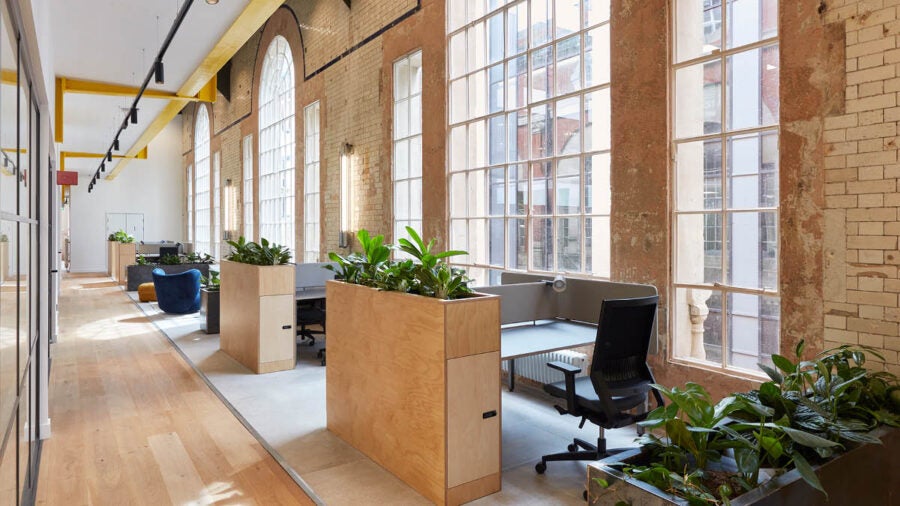
The working lives of Generation Z began at home in bedrooms, living rooms and kitchens during the pandemic. With offices and co-working spaces closed, the youngest members of the workforce were forced to hone their skills and communicate with their new colleagues over Zoom calls, Slack channels and Whatsapp groups.
But going virtual has not been without its perks. Gen Z was spared the years of long commutes endured by their older co-workers and became accustomed to a more balanced way of working. With business as usual resuming, it was thought that younger workers would ditch the office in droves, favouring entirely remote, digitally nomadic opportunities. And just like that, the humble office would soon be obsolete.
Young people need diverse office facilities that provide the opportunity to collaborate and socialise with colleagues but also space to work alone and focus
However, this assumption misses the mark. In 2021 flexible workspace provider, Clockwise commissioned a survey revealing that 60% of Gen Z workers would prefer to work from an office space part-time. Nearly a third of those surveyed longed for social environments and struggled to create separation between their personal and work lives when working from home.
Early disruptors on the co-working scene tapped into something great, advocating for a more casual approach to corporate environments. But, since this concept broke into the mainstream in the early 2010s, little has been done to move this concept forward.
With employees being granted greater freedom over their schedules, increased digitisation, and a rise in freelancers and contingent workers, businesses are offering more flexibility across the board. However, organisations that advocate a flexible approach for their employees are still locked into fixed contracts as they would with a traditional office lease.
Innovations in communal workspaces are picking up. Clockwise, for example, allow businesses to scale their office footprint up or down depending on the growth of their teams. This demonstrates a keen awareness of how work is changing on a practical level. The agility that organisations nourished throughout the pandemic must now be reflected in the changing face of workplaces.
Alexandra Livesey, chief operating officer at Clockwise, spots a pattern emerging. “A growing number of big brands are taking smaller offices within our space,” she says. Two-thirds of Gen Z workers that relocated from urban areas during the pandemic don’t plan on moving back to big cities. Employers are stuck. Livesey explains: “They don’t want to commit to regional offices on a long-term basis, and they want to provide at least the same quality as their head office, which is improving staff retention.”
Employee benefits likewise reflect the changing business landscape. Alongside flexible work, almost three-quarters of Gen Z employees said added facilities were something they looked for as part of their working package when seeking new employment. But most employers do not have the capex, expertise or the time and energy to try and build these facilities out themselves for their teams. Paying for a small office and getting all the amenities included can be transformative.
For teams to make the most of time spent in offices, the approach must be more than skin deep. Livesey outlines the rationale behind Clockwise’s carefully designed workspaces. “[Young people] need diverse office facilities that provide the opportunity to collaborate and socialise with colleagues but also space to work alone and focus,’’ she says.
Acoustic design and maximising exposure to natural light are vital considerations for Clockwise. Every detail is designed to aid energy levels, focus and mood. There is no one-size-fits-all solution. Standing desks, breakout spaces, meeting rooms, outdoor terraces, kitchenettes, and even podcast recording studios allow workers to personalise their working environment, mix with coworkers and work collaboratively or alone.
To top it off, employers cannot overlook workplace sustainability. A recent Bupa survey revealed that 64% of Gen Z workers want their employers to act on environmental issues, and 31% said they would go as far as to turn down an employer with poor ESG credentials.
Rising to the challenge is not straightforward, but co-working could be a step in the right direction. Clockwise demonstrates how communal workspaces can continue to innovate, despite their already strong popularity. Their recently launched Positive Impact Strategy outlines four core ambitions: achieving carbon neutrality, operating in a circular economy, designing healthy workspaces that promote employee wellbeing, and ensuring a positive socio-economic impact.
As Gen-Z continues to dictate the future workplace, businesses that embrace sustainable, sociable, and healthy workspaces will have an edge.
For more information, visit work-clockwise.com

The working lives of Generation Z began at home in bedrooms, living rooms and kitchens during the pandemic. With offices and co-working spaces closed, the youngest members of the workforce were forced to hone their skills and communicate with their new colleagues over Zoom calls, Slack channels and Whatsapp groups.
But going virtual has not been without its perks. Gen Z was spared the years of long commutes endured by their older co-workers and became accustomed to a more balanced way of working. With business as usual resuming, it was thought that younger workers would ditch the office in droves, favouring entirely remote, digitally nomadic opportunities. And just like that, the humble office would soon be obsolete.
Young people need diverse office facilities that provide the opportunity to collaborate and socialise with colleagues but also space to work alone and focus

